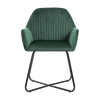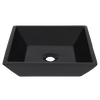Turn an outdoor space into a personal retreat with gazebos and canopies
Ever fancied a cosy nook in your garden where you can unwind, read a book or host a lively get-together? With the right gazebo or canopy, you can transform any patch of grass into a stylish hangout spot. No need for grand plans — just a simple setup, and you’re good to go with a smart outdoor shelter.
The beauty and functionality of the gazebo
Choosing a canopy or gazebo can transform your outdoor living space into a versatile, inviting area that's ready for any occasion. Here’s why you might consider adding one to your garden or yard.
1. Enhanced outdoor comfort
Canopies and gazebos provide a pleasant shade from the sun, making your outdoor space usable even during the brighter, hotter parts of the day. They create a cool retreat, allowing you and your guests to relax outside without the hassle of oppressive heat.
2. Flexibility for all events
Canopies and gazebos are great for any event, whether it's a family barbecue, an elegant outdoor wedding or a casual evening with friends. They offer a defined space that can be decorated and themed as needed, making every gathering feel more special and organised.
3. Protection from the elements
Beyond just the sun, these structures also offer protection from unexpected rain, ensuring that your outdoor activities can continue regardless of a sudden weather change. This makes them ideal for planning events without the worry of weather disruptions.
4. Instant aesthetic upgrade
Canopies and gazebos are available in various styles, from modern minimalist to ornate traditional designs. Each can complement your garden’s aesthetic. They serve not only as functional additions but also as focal points that enhance the visual appeal of your outdoor space.
5. Ease of installation and mobility
Many canopies and gazebos are designed to be easy to set up and take down. Portable models allow you to move your shaded area as required, whether you're adjusting for the sun's position or rearranging your space for different events.
The difference between a canopy and a gazebo
The terms "canopy" and "gazebo" sometimes get used interchangeably, but they refer to different types of structures. Each has its unique characteristics and uses in an outdoor setting. Here’s a breakdown of the differences between canopies and gazebos.
Canopy
Canopies typically have a lightweight, portable design. They consist of a fabric cover stretched over a frame that is usually made of metal or plastic. The frame is collapsible, making canopies easy to set up and take down.
-
Usage: Canopies are often used for temporary events like picnics, outdoor markets or beach outings. They provide quick and flexible shelter, suitable for temporary shade or protection from light rain.
Gazebo
Gazebos are more robust and permanent structures compared to canopies. They typically consist of a hard roof mounted on a more permanent frame, which can be made of wood, metal or vinyl. Gazebos often have a hexagonal or octagonal shape.
-
Design: Gazebos can be quite ornate, featuring detailed designs including built-in seating, decorative railings and even electrical fittings for lights and fans. They are often used as an attractive focal point in garden design.
Tips for choosing the right canopy or gazebo
Choosing the right canopy or gazebo for your outdoor space involves several considerations to ensure you get the most out of your investment. Here’s some tips to guide you in selecting the ideal option.
1. Purpose
Think about what you primarily need the canopy or gazebo for. Is it for hosting parties, providing a quiet place to relax or covering your hot tub? Different uses require different styles, sizes and materials. For example, a gazebo for entertaining might need to be larger and more robust than one intended for personal relaxation.
2. Size and shape
Measure the area where you plan to set up the canopy or gazebo to ensure it fits comfortably. Consider both the ground space and the height, especially if you plan to place it near trees or under other overhead structures. The shape — whether it’s rectangular, square or octagonal — can also affect how it fits into your space and how people move around inside it.
3. Material
The durability and appearance of your canopy or gazebo depend significantly on the materials used.
-
Canopies are often crafted from polyester or canvas. Polyester is lightweight and water-resistant, ideal for occasional use, whereas canvas is heavier, more durable and better suited for semi-permanent structures.
4. Style
Choose a style that complements your home’s exterior and your garden's design. Gazebos and canopies come in various styles, from traditional with ornate features to modern and minimalist. The right style can enhance the overall aesthetics of your outdoor area.
5. Features
Consider additional features that might be useful.
-
Mosquito nets can be essential for evening use in bug-prone areas.
-
Side panels offer added protection from the elements and increased privacy.
-
Ventilation features in the roof can help regulate temperature and keep the air fresh inside.
6. Portability and assembly
If you foresee a need to move your gazebo or take it down seasonally, look for models that are designed for easy assembly and disassembly. Portable canopies are ideal for events like beach outings or picnics.
How to care for and maintain your canopy or gazebo
Enhancing the durability and appearance of your canopy or gazebo involves consistent care and maintenance. By adopting simple yet effective routines, you can protect your outdoor structures from wear and deterioration.
Canopy care
Regularly clean the fabric of your canopy using a mild soap and water solution, gently scrubbing with a soft brush before rinsing and allowing it to air dry completely. Check the frame for debris or rust, clean it with a damp cloth and treat any rust found. Store the canopy in a cool, dry place and ensure it is dry before storage to prevent mould.
Inspect the canopy and frame for tears, holes or structural damage. To prevent deterioration, repair minor issues with a repair kit.
Gazebo maintenance
Sweep the roof and clean all surfaces regularly. Use appropriate cleaners for different materials, and annually inspect the structure for wear or damage, making necessary repairs and replacements.
Apply a water-repellent sealant to the wood every few years and ensure metal coatings are intact. In areas with harsh winters, prepare your gazebo by removing fabric elements and securing the structure.
Essential additions to elevate your garden
When planning your garden, adding a few key elements can transform it into a functional and inviting outdoor living space. Here’s four must-have items that can enhance any garden,
1. Outdoor furniture
Investing in good outdoor furniture is great for creating a comfortable space to relax and entertain. Consider pieces that suit your lifestyle, whether it’s a dining set for al fresco meals, cosy loungers for sunbathing or a swing seat for gentle relaxation. Choose materials that withstand the elements, like treated wood, metal or synthetic rattan.
2. Water features
Adding a water feature such as a fountain, pond, or waterfall can bring a sense of tranquillity and elegance to your garden. The sound of flowing water is not only soothing but also helps attract wildlife. Water features come in various sizes and styles, so you can find one that fits your garden's theme and space requirements.
3. Planters and raised beds
Incorporate planters and raised beds to make gardening more manageable and aesthetically pleasing. These are excellent for growing flowers, herbs and vegetables. They provide better soil control and drainage and are easier on your back. Choose materials and colours that complement your outdoor decor.
4. Lighting
Proper outdoor lighting can make your garden a delightful place even after dusk. It enhances safety, highlights key features of your landscape and creates a warm ambience. Options include solar path lights, string lights for a festive look or LED spotlights to accentuate trees and shrubs.































































